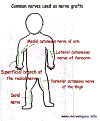PeripheralNerves.com
|
PeripheralNerves.com |
|
|
Obstetric Brachial Plexus Palsy (OBPP)Sub-topicsIntroduction / Aetiology / Classification / Clinical Features / Diagnosis (Electrophysiology) / Prognosis / Treatment / Surgery / Results / Late Effects of OBPP. SurgeryWhen the roots of the plexus are identified, somatosensory evoked potentials (SSEP) are recorded from these. This tests whether impulse conduction pathway from the nerve roots up the spinal cord ascending to the cerebral cortex is intact. If good SSEPs are recorded, then it's unlikely that the nerve root is avulsed from the spinal cord. Motor conduction is also tested for by stimulating proximal to the lesion and looking for muscle activity in the corresponding muscle groups.
Nerve GraftingThe nerve lesion are excised to healthy ends. The length of the gap is measured. The length of nerve graft to be harvested is calculated. The graft cut into the required length and is interposed between the two ends. The graft is secured into place using tisseal glue (See Picture 1 below). Sadly there are no spare nerves to act as grafts. The commonest donor nerves are cutaneous or sensory nerve so as to lead to minimal functional loss. These are the medial cutaneous nerve of arm, superficial branch of the radial nerve, sural nerve and less occasionally, lateral cutaneous nerve of forearm which is the terminal branch of the musculocutaneous nerve and posterior cutaneous nerve of the thigh (See Picture 2 below). 
Picture 1 Picture 2 (Click for larger image) Treatment for avulsionsThis is very a difficult problem. The spinal accessory nerve can be used to innervate the suprascapular nerve so that useful shoulder function can be regained. The premise that a good shoulder and elbow function without good hand function is of no great benefit has lead some surgeons to innervate the lower trunk (which controls the hand function) using one or two ruptured upper roots. This called intra-plexal transfer. After repair/ grafting the limb has to be immobilised in a splint or plaster jacket for 4 to 6 weeks. This so that the nerve graft does not displace before it heals. Results of RepairA surprising feature through the grafts in OBPP is it's slowness as compared to adult Brachial plexus grafting. The shoulder and elbow recovery takes around 9 months. Wrist extensors recover between 12 to 18 months and the wrist and hand flexors and small muscles of the hand, 18 to 24 months. In contrast, the trophic state of the limb improves much earlier. Vasomotor control and sweating become apparent about 6 months after repair. The recovery of shoulder, elbow and hand function is evaluated using various scoring systems. It has been found that the outcome of repair is better than in non-operated patients. An intra-plexal repair has been found to give good hand function in spite of weak wrist extension. Overall a good functional recovery can be expected in 65 - 80% of children undergoing an early repair. |
|
Send mail to [email protected] with
questions or comments about this web site.
|